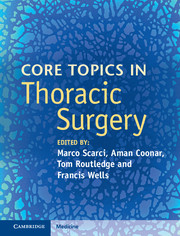Book contents
- Frontmatter
- Contents
- List of contributors
- Section I Diagnostic work-up of the thoracic surgery patient
- Section II Upper airway
- Section III Benign conditions of the lung
- Section IV Malignant conditions of the lung
- Section V Diseases of the pleura
- 18 Tube thoracostomy: evidence-based management of chest drains following pulmonary surgery
- 19 Primary spontaneous pneumothorax
- 20 Bronchopleural fistula management
- Section VI Diseases of the chest wall and diaphragm
- Section VII Disorders of the esophagus
- Section VIII Other topics
- Index
- References
20 - Bronchopleural fistula management
from Section V - Diseases of the pleura
Published online by Cambridge University Press: 05 September 2016
- Frontmatter
- Contents
- List of contributors
- Section I Diagnostic work-up of the thoracic surgery patient
- Section II Upper airway
- Section III Benign conditions of the lung
- Section IV Malignant conditions of the lung
- Section V Diseases of the pleura
- 18 Tube thoracostomy: evidence-based management of chest drains following pulmonary surgery
- 19 Primary spontaneous pneumothorax
- 20 Bronchopleural fistula management
- Section VI Diseases of the chest wall and diaphragm
- Section VII Disorders of the esophagus
- Section VIII Other topics
- Index
- References
Summary
A bronchopleural fistula (BPF) is an abnormal connection between the bronchial tree and the pleural space. The development of a fistula following pulmonary resection due to a bronchial stump dehiscence is a rare and potentially fatal complication. The incidence is reported as between 1 to 20% following pneumonectomy and 0.5% after lobectomy, and reported mortality varies between 20 and 70%. The risk of death is highest when a fistula presents within the first 2 weeks after surgery, and the main cause of death is aspiration pneumonia.
The most common aetiology of a bronchopleural fistula is a complication of pulmonary resection, either segmentectomy, lobectomy or pneumonectomy. This chapter will focus upon post-operative fistulae, but they can occur in the non-operative setting. Non-operative fistulae can be caused by a necrotizing pneumonia or empyema and neoplasms of lung, thyroid, oesophagus or the lymphatic system. Also, they can be secondary to blunt or penetrating chest trauma or as a complication of medical procedures such as radiotherapy, lung biopsy or chest drain insertion. The ‘air leak’ responsible for causing a pneumothorax is often erroneously referred to as a bronchopleural fistula, but these leaks are alveolarpleural fistulae, rather than the more proximally located bronchopleural fistulae.
The risk factors for post-resection fistula formation can be classified into pre-operative, intra-operative and post-operative factors. Table 20.1 shows a list of risk factors which have been suggested to predispose to BPF after lung resection. Pre-operative factors focus upon co-morbidities, drug history and any pre-operative oncological treatment. Algar et al. found a significant association between development of BPF and COPD, hyperglycaemia, hypoalbuminaemia, steroid therapy and low predicted post-operative FEV1. A multivariate analysis by Asamura et al. of risk factors for BPF in 1,360 pulmonary resections for lung cancer reported similar findings but in addition found an increased risk associated with liver cirrhosis and pre-operative radiotherapy in excess of 5,000 Gy.
Intra-operatively, Asamura et al. identified right-sided resection, pneumonectomy (especially right-sided), mediastinal lymph node dissection and residual carcinoma at the bronchial stump as technical factors predisposing to fistula formation. Also, long and devascularized bronchial stumps are reported as risk factors. The mechanisms for the increased risk related to right-sided resections are two-fold. Firstly, the right main bronchus is usually supplied by one bronchial artery, whereas the left is supplied by two bronchial arteries.
- Type
- Chapter
- Information
- Core Topics in Thoracic Surgery , pp. 193 - 198Publisher: Cambridge University PressPrint publication year: 2016
References
- 1
- Cited by

